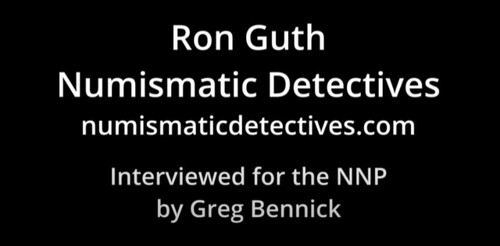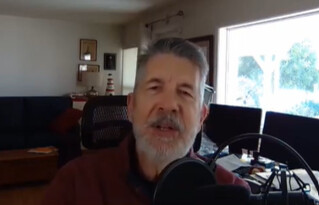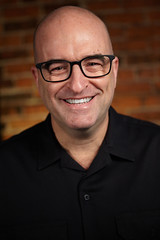
PREV ARTICLE
NEXT ARTICLE
FULL ISSUE
PREV FULL ISSUE
RON GUTH INTERVIEW, PART FOURGreg Bennick's latest interview for the Newman Numismatic Portal is with author, researcher and Numismatic Detective Ron Guth. Here's the fourth and final part, where Ron talks about his interest in German coins. Thanks to Ron, Greg, and the Newman Numismatic Portal for making this happen. -Editor
Ron Guth: I started specializing in German coins in 1988. I sort of got into that accidentally,
but I really like the German coin series. It's a huge, vast series that covers centuries. The
designs are incredible, the denominations are incredible. But my favorite is the Bavarian thalers
from 1753 to about 1800. They have the portrait of the king on the front and on the back, they
have Madonna and child, the Madonna child of the patron…she's a patroness of Bavaria. And
so they're beautiful coins and they're silver dollar size. The thaler, of course, is the early
ancestor of the Greg Bennick: Is there a definitive reference on German thalers? I've got a book in the other room and I can't remember who wrote it that I think might be a reference. I don't know if it's definitive or not, but did somebody write the book on them?
Greg Bennick: I'm fascinated by the specificity of German thalers of this date to this date in your area of interest. I, for example, collect condor tokens and condor token errors, but I'll only collect a condor token error if I can get a non-error version of the same to match them up. So if there was a condor token error that was on a unique piece, I probably wouldn't be interested because I don't have the match of the non-error version. And one of these days I need to interview a psychologist and just figure out what's wrong with all of our brains. (both laugh) Like why are we doing this? Why the specificity? Why does that interest me? Why does this interest you? It's just really interesting. Ron Guth: Yeah, the collecting bug is very interesting. You know, why do people collect beer cans? Why do people collect matchbooks? You know, you can pick anything and people get all excited about it. And I'm like you, I don't know what it is, why did I get bitten by the collecting bug? I'm glad I did. People look at me like what are you doing? Or how can you make money buying a coin from one guy and selling it to another? They just don't get it. Or why do you want to get three hundred different Bavarian thalers? People who don't have the collecting bug don't understand it, but those who do have the collecting bug enjoy it, whether it's beer cans or coins. Greg Bennick: It's so true. My father wrote a a book on his collection of railroad tokens called A Compendium of Railroad and Railroad Related Metals and Tokens and I thought that he was out of his mind. But then I realized that I have literally the same mind, like genetically the same mind. So we've all, in the collecting world, have these little idiosyncratic fascination points. And I think that's the beauty of this, whether it's railroad related medals and tokens or German thalers or error coins, whatever it might be. I think that the collecting mind is fascinating, I'm just constantly amazed by it. So, I'm glad you told us about the German coins.
Ron Guth: Yeah. It is wonderful because no matter what you collect, there are infinite ways to
collect it. Like when we were kids, we put together the Whitman albums and filling the holes
and trying to get completion. And today, now it's a flight to quality. You can collect whatever
you want. Jeff Garrett just wrote a great article about Greg Bennick: Great. So last question for you. Tell us about your stint as PCGS president. It was between, I think, 2005 and 2008. Do I have that right? Ron Guth: Yeah. I mentioned earlier that I sold Coin Facts to PCGS in 2004 and I became the research director at that time, you know, basically maintaining Coin Facts for them. Well, the opportunity arose in 2005 to take over the presidency of PCGS which is the coin grading arm of Collector's Universe. So I jumped into that, and that was probably one of the highlights of my career because I got to work side by side with David Hall, and I got definitely a commanding view of the entire coin market. I knew who all the players were, how they operated. I learned the ins and outs of coin grading, how the business is run, why its important, consumer protection, you know, all the different aspects of the coin grading. So I did that for three years. And then 2008 we decided to really pump PCGS Coin Facts up. And so I shifted over to the Coin Facts side of it, and Don Willis took over as PCGS U.S. president, and the rest is history. Greg Bennick: That's pretty amazing. I'm so glad that A. I've gotten a chance to talk to you today. B, that you've offered so many different avenues for us to explore and think about in the coin hobby, both the collector side and the collector mind as we talked about. And as a researcher, because people I hope will take away from this that they can explore and examine coins from a researcher's perspective, even considering writing books on topics. And you gave a good example, for example, of German thalers and how there's no necessarily definitive work, and maybe somebody could fill that empty space. And then just the also structural side of the coin hobby, the fact that there are clubs and organizations that people could get involved with, become the president of, and contribute that way to the hobby. All that's really fascinating. So I think those are the questions that I've prepared and that I had for you. So thank you so much for your time. Did we miss anything critical or anything important that you wanted to add on before we go? Ron Guth: No, I think you came up with some great questions. Thank you for having me on. And keep up the good work, I've enjoyed your interview with Jeff Garrett so far and keep it up. As I told you before the interview, I think the preservation of this information is great because we're not going to be around here forever and we need to get into the brains of important people in the industry and find out their stories because everybody has a story and every story is different. So please keep up the good work. Greg Bennick: I appreciate that very much. All right, we'll stay on for a couple of minutes. But everybody, I'll sign off and say, if you're interested in more interviews, please check out the Newman Numismatic Portal. I'm Greg Bennick, I'll be conducting more interviews and you can check them all out there. Thanks so much, Ron. I appreciate it very much. Ron Guth: You're welcome. Thank you.
To watch the complete video, see:
To read the complete transcript, see:
To read the earlier E-Sylum articles, see:
Wayne Homren, Editor The Numismatic Bibliomania Society is a non-profit organization promoting numismatic literature. See our web site at coinbooks.org. To submit items for publication in The E-Sylum, write to the Editor at this address: whomren@gmail.com To subscribe go to: https://my.binhost.com/lists/listinfo/esylum All Rights Reserved. NBS Home Page Contact the NBS webmaster 
|



